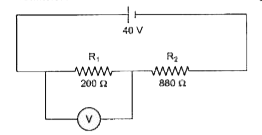For two resistors R1 and R2, connected in parallel, find the relative error in their equivalent resistance. if R1=(50±2)Ω and R2=(100±3)Ω.
The correct Answer is:0.036
To find the relative error in the equivalent resistance of two resistors R1 and R2 connected in parallel, we can follow these steps:
Step 1: Understand the formula for equivalent resistance in parallel
The equivalent resistance Req for two resistors R1 and R2 connected in parallel is given by the formula:
1Req=1R1+1R2
This can be rearranged to:
Req=R1R2R1+R2
Step 2: Substitute the values of R1 and R2
Given:
- R1=50±2Ω
- R2=100±3Ω
Substituting the nominal values into the formula:
Req=50×10050+100=5000150=1003Ω≈33.33Ω
Step 3: Differentiate the equation for error propagation
To find the relative error in Req, we use the formula for error propagation in functions of multiple variables. The differential form gives us:
δReq=R2eq(δR1R21+δR2R22)
Where δR1 and δR2 are the uncertainties in R1 and R2.
Step 4: Substitute the uncertainties and values into the equation
We know:
- δR1=2Ω
- δR2=3Ω
Now substituting into the error propagation equation:
δReq=(1003)2(2502+31002)
Calculating each term:
δReq=(1003)2(22500+310000)
=(1003)2(820000)
=(100009)(820000)=80000180000=818≈0.4444Ω
Step 5: Calculate the relative error
The relative error in the equivalent resistance is given by:
Relative Error=δReqReq
Substituting the values:
Relative Error=0.444433.33≈0.0133
Step 6: Final result
To express the relative error as a percentage:
Relative Error≈0.0133×100≈1.33%
Thus, the relative error in the equivalent resistance is approximately 1.33%.
---
The equivalent resistance Req for two resistors R1 and R2 connected in parallel is given by the formula:
1Req=1R1+1R2
This can be rearranged to:
Req=R1R2R1+R2
Given:
- R1=50±2Ω
- R2=100±3Ω
Req=50×10050+100=5000150=1003Ω≈33.33Ω
To find the relative error in Req, we use the formula for error propagation in functions of multiple variables. The differential form gives us:
δReq=R2eq(δR1R21+δR2R22)
Where δR1 and δR2 are the uncertainties in R1 and R2.
We know:
- δR1=2Ω
- δR2=3Ω
δReq=(1003)2(2502+31002)
δReq=(1003)2(22500+310000)
=(1003)2(820000)
=(100009)(820000)=80000180000=818≈0.4444Ω
The relative error in the equivalent resistance is given by:
Relative Error=δReqReq
Substituting the values:
Relative Error=0.444433.33≈0.0133
To express the relative error as a percentage:
Relative Error≈0.0133×100≈1.33%
Similar Questions
When two resistors of (600±3) ohm and (300±6) ohm are connected in parallel, value of the equivalent resistance is
View SolutionTwo resistors having resistance 4 Ω and 6 Ω are connected in parallel. Find their equivalent resistance.
View SolutionThree resistors of 2Ω,3Ω and 4Ω are connected in
parallel. Draw the arrangement and find the equivalent resistance in each case.
View SolutionShow by a diagram how two resistors R1andR2 are joined in parallel. Obtain an expression for the total resistance of the combination.
View SolutionTwo resistor R1=(24±0.5)ΩandR2=(8±0.3)Ωare joined in series, The equivalent resistence is
View SolutionTwo resistor of resistance R1=(6±0.09)Ω and R2=(3±0.09)Ω are connected in parallel the equivalent resistance R with error (in Ω)
View SolutionA combination of two resisters R1 and R4 are placed in an electrical circuit. In an experimental arrangement, the resistance are measured as R1=(100±3)Ω,R2=(200±4)Ω
The equivalent resistance, when they are connected in parallel, 1RP=1R1+1R2 can be expressed as
View SolutionTwo resistors of resistance R1 and R2 having R1>R2 are connected in parallel. For equivalent resistance R, the correct statement is
View SolutionTwo resistors of resistance R1 and R2 having R1>R2 are connected in parallel. For equivalent resistance R, the correct statement is
View SolutionFigure below shows two resistors R1andR2 connected to a battery having an emf of 40 V and negligible internal resistance. A voltmeter having a resistance of 300 Ω is used to measure potential difference across R1 Find the reading of the voltmeter.

View Solution
